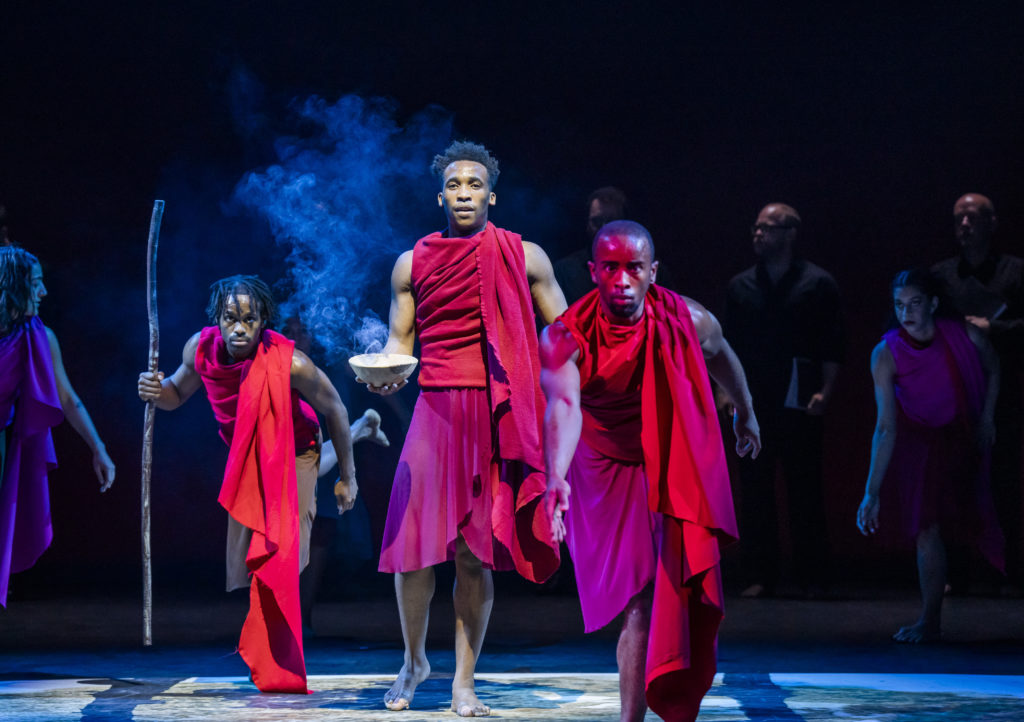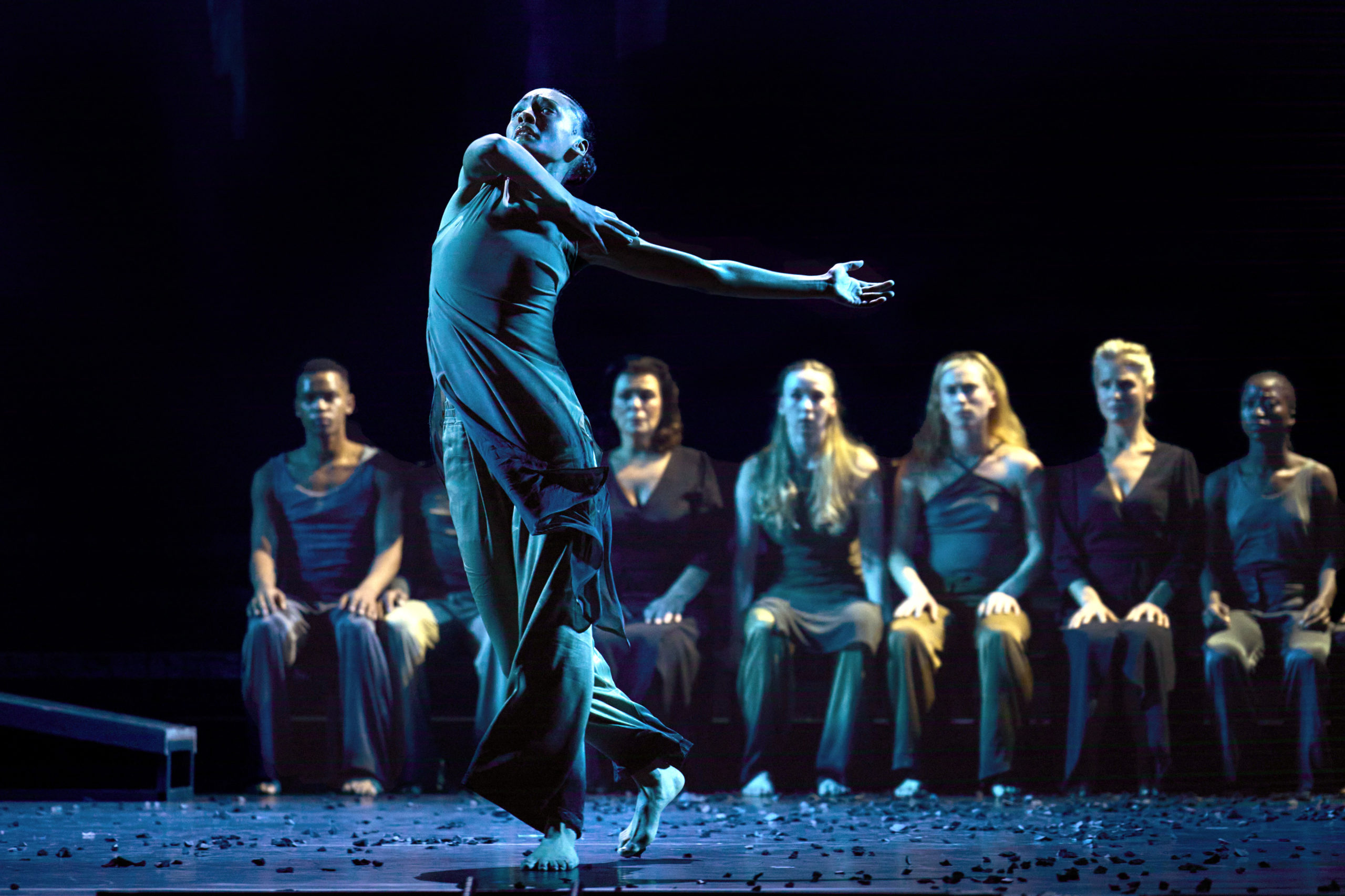Words by Klara Pertmann. Klara is part of our Guest Writers development programme, which is supported by Arts Council England.
I am someone with many existential anxieties – of death being one of them, so I hope to be the perfect indicator for how this subject is handled in the double-bill, Requiem – Journeys of the soul. The title itself reads like a promise of a shift in perspective, so I am both nervous and excited to see what this journey, directed and choreographed by Dane Hurst, entails.
The stage is dark, and lays silent until bodies (ensemble of Jazzart Dance Theatre and Phoenix Dance Theatre) crawl onto the stage in an organic mess, making it pleasingly difficult to separate body part from body part. They bring ennui to the air and dirt to the floor, reminding me: “For dust you are, and to dust you shall return”, and soon this return begins with the voices of the Opera North chorus. It sets the tone of the piece clearly: something serious is happening. But if it is so serious, why is it dragging?
Mozart’s Requiem is an overwhelming piece of music to take on, and overthinking the weight of its soundscape seems to restrict the creative energy from flowing both in process and performance, meaning aspects of the piece are played with less than expected. The significance and context of the piece are handled with too much respect; respect towards the music, respect towards classical movement vocabulary, and respect towards the theatre as an institution. This results in a successful seriousness, but one that lacks a sense of real urgency.
The set-design is a grey underworld, with timeworn fabric hanging from the ceiling. Church-like rows of benches allow for strong imagery when used intentionally, for example when filled up with soloists, Ellie Laugharne, Ann Taylor, Mongezi Mosoaka, and Simon Shibambu, and ensemble dancers sitting in a row, awaiting their judgement. They stand up one by one, threatening to leave. Desperately, they grab each other’s hands to prevent departure. The earnest touch of hand to hand, equally tender to the occasional eye contact or movements of embrace, are simple manifestations of human connection, a link that stretches through the theatre and includes me. These moments are unfortunately few and fleeting, as for most of the piece the chorus and dancers stay spatially separated. Their distance is further enhanced by different costumes: the chorus in black and dancers in grey, hinting of characters that remain unclear.
The movement is beautiful, in the rather limited definition of the word. Physical, but performed with ease, I find myself yearning, searching, for a sweat stain or drop, a flushed face, or a tremble. If death is dreadful, life full of agony, and human collapse is close, then the body should reveal signs. An impressive commitment to dramatic performance, combined with choreography that lacks moments of resistance and fight, makes the struggle appear unauthentic. I re-experience the ceremony of my grandmother, where a 15-year old me looked up at the adult guests wondering if their crying was real or not. At that funeral, I also remember hearing my grandfather whisper: “See you soon” and how I got a glimpse of the human in him. The simplicity of those words, functioning as proof of true tragedy, is what I am missing on stage.
There are moments that do take a hold of my heart and squeeze it tightly, like in a solo performed to Lacrimosa, where the dancer is falling, twisting, and gasping, all alone, and I can sense the urgency of a surface breaking. However, just as I am starting to believe her performance, it is interrupted by the self-aware presentation of a pretty leg. “No, please put it down again”, I sigh, “Let the body be what it already is”. Ah, all those lines, so carefully arranged. How I wish that was how my body reacted and took shape when reminded of the potential nothingness that awaits at the end of life.

Confused over the absence of melancholia or anxiety in me, the second piece, After Tears: After a Requiem, comes as a surprise. The chorus of Opera North and dancers of Phoenix Dance Theatre are joined by dancers from Jazzart Dance Theatre, a Cape Town-based company. Through this collaboration the choreography is influenced by South African movement vocabulary and cultural tradition.
There is a sense of vitality on stage, and contrasting the dark funeral, the dancers are dressed in orange, yellow and fuschia. Unfortunately, the choir is still stuck in their all-black uniform, and though they at least are barefoot, they remain separated from the dancers. When the lights cast cold blue on the chorus and warm yellow on the dancers, it creates an unfortunate dichotomy between moving and standing still, South African movement and classical opera. A similar split peeks through when steps are glued together in a forced manner, making them identifiable as separate techniques, calling for an inner reflection on dance history. But the two companies move like one, embodying the choreography into a cohesive and textured form, guiding me through the otherwise solid piece.
It is a story of ritual and celebration, told through text: “Come bring the dance!”, circles, smiles, and rhythm. The musical score by Neo Muyanga, is vibrant, peculiarly nostalgic, and equally impressive live as the iconic Mozart’s Requiem; especially when overlaid with sounds of exclamations, chants, feet stomping and hands clapping. It is a fun whirlwind of visual and sonic fragments, mostly successfully brought together through a joyful commitment of all involved. My eyes follow two of the dancers from Jazzart Dance Theatre, Vuyelwa Phota and Savannah Petrus. They radiate energy, they are enjoying their own presence; flirting with themselves, the audience, and the other company-member, as sweat drips from their human bodies. I believe them!
The performed ceremony is speaking of a journey not only of the soul, but also of history and interpretation of culture. Death at first seems totally absent from the party, but as I become more and more aware of life’s capacities, I realise my own preformed idea of death is irrelevant and unnecessary. The energetic movement says there is life in death, and death in life, there is optimism in melancholia, and manic energy released through loss. This is communicated through physical language; the living body as a reminder of its own possibilities.
My soul was indeed taken on a journey, from an underground funeral, to a colourful celebration in the sun. I am slightly underwhelmed by how death, and the existential questions it usually poses, are totally absent from my otherwise always spiralling being. Either the performance cured my anxiety, redefined my concept of death, or didn’t fully touch its subject. Maybe all of them.
Header image by Richard H. Smith.
